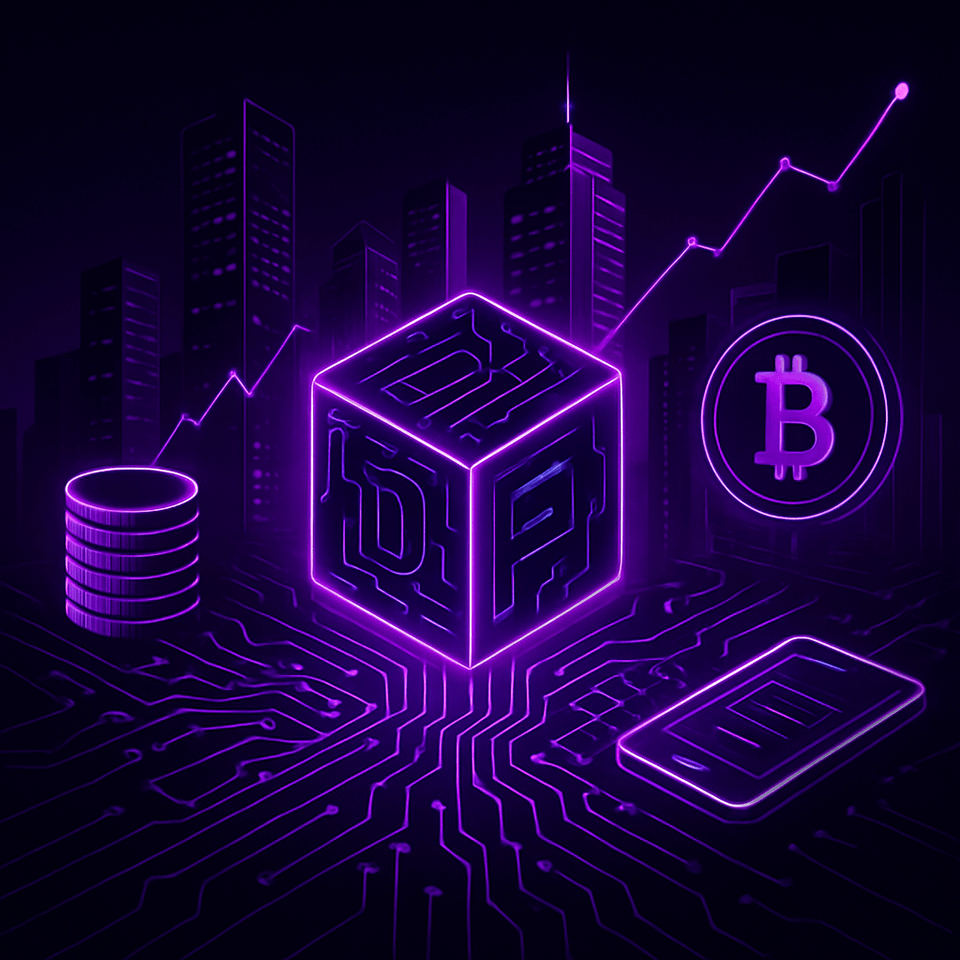The traditional financial system, built on centralized institutions and intermediaries, is facing its most significant challenge yet. Decentralized Finance (DeFi) has emerged as a transformative force that is reshaping how we think about money, banking, and financial services. With the global DeFi market projected to grow from $20.48 billion in 2024 to an astounding $231.19 billion by 2030, representing a compound annual growth rate of 53.7%, the question is no longer whether DeFi will disrupt traditional finance, but how quickly this transformation will occur. This analysis examines the five key advantages that position decentralized finance as the inevitable future of the global financial system, drawing insights from leading European and American financial institutions and regulatory bodies.
DeFi Market Growth Projections (2024-2030): Market size and user adoption showing exponential growth trajectory
The paradigm shift toward decentralized finance represents more than just technological advancement; it embodies a fundamental reimagining of how financial systems should operate in the digital age. Unlike traditional banking systems that rely on centralized authorities, intermediaries, and legacy infrastructure, DeFi operates on blockchain networks using smart contracts to automate financial services without the need for trusted third parties. This transformation is being closely monitored by major regulatory bodies, including the Federal Reserve, which has acknowledged DeFi’s “transformative potential,” and the European Central Bank, which recognizes its role as “a novel way of providing financial services that cuts out traditional centralized intermediaries”.
Global Accessibility and Financial Inclusion
The most compelling advantage of DeFi lies in its ability to democratize access to financial services on a global scale. Traditional banking systems exclude approximately 1.7 billion adults worldwide from basic financial services, with 1.1 billion of these individuals having access to mobile phones but no banking infrastructure. DeFi eliminates these barriers by requiring only an internet connection and a digital wallet, creating what the World Economic Forum describes as a “leapfrog technology” that enables underserved communities to bypass traditional financial infrastructure entirely.
Infographic illustrating the process and requirements for transitioning from unserved to served individuals in the financial system, highlighting financial inclusion gateways and needed support measures.
European and American financial institutions have recognized this transformative potential. The European Central Bank notes that DeFi’s “non-custodial” nature allows “participants to manage their digital assets directly without any centralized intermediary”. This approach is particularly revolutionary in developing economies, where DeFi platforms are already serving as alternatives to traditional banking systems that have failed to reach rural and underbanked populations.[2][6][7]
The accessibility advantage extends beyond geographical boundaries. DeFi platforms operate 24/7/365, unlike traditional banks constrained by business hours and geographical limitations. This constant availability, combined with permissionless access, means that individuals in regions with limited banking infrastructure can access lending, borrowing, trading, and investment services without requiring authorization from centralized institutions. Research indicates that 32% of DeFi users in emerging markets utilize these platforms specifically to access capital in underbanked economies, demonstrating the technology’s real-world impact on financial inclusion.[8][6][9]
The cost structure of DeFi accessibility represents a dramatic departure from traditional banking. While traditional banks incur $100-300 per customer for document verification and account setup, DeFi platforms enable onboarding with near-zero costs, requiring only smartphone access and internet connectivity. This cost efficiency has enabled DeFi platforms to reach over 2.4 billion underbanked individuals as of 2025, representing a 32% increase from the previous year.[10][11]
Enhanced Transparency and Trust Through Immutable Records
Traditional financial systems operate largely as “black boxes,” where consumers have limited visibility into how their money is managed, how decisions are made, or how fees are calculated. DeFi fundamentally disrupts this opacity through blockchain technology, which creates an immutable, publicly accessible ledger of all transactions. Every financial operation, from simple transfers to complex lending arrangements, is recorded transparently and can be verified by anyone, creating unprecedented levels of accountability in financial services.
Key benefits of smart contracts include no middlemen, cost savings, autonomous and trustless execution, code-based governance, error resistance, and defect backups.
The transparency advantage is particularly evident in smart contract operations. The Federal Reserve acknowledges that these “self-executing contracts with terms directly written into code” eliminate the need for intermediaries while providing complete transparency of operations. When a DeFi lending platform like Aave or Compound executes a loan, all terms, conditions, collateral requirements, and interest calculations are visible on the blockchain, allowing borrowers and lenders to verify the system’s operations independently.
This transparency extends to governance and operational decisions. Unlike traditional banks where fee structures and policy changes are determined behind closed doors, DeFi protocols often employ decentralized governance models where token holders can participate in decision-making processes. The European Securities and Markets Authority (ESMA) has noted that this transparency “enhances trust and security in cross-border dealings” and reduces the risk of fraud and manipulation.
The immutable nature of blockchain records provides additional security benefits that traditional systems cannot match. Once transactions are recorded on the blockchain, they cannot be altered or deleted, creating a permanent audit trail. This immutability, combined with cryptographic security, ensures that financial agreements are honored exactly as written, reducing the risk of fraud and providing a higher level of security for users.
Real-world applications demonstrate the practical benefits of this transparency. In supply chain financing, companies using DeFi solutions report real-time tracking capabilities, automated payments through smart contracts, and enhanced efficiency through the elimination of intermediaries. These transparent operations have reduced transaction costs by 40-80% while increasing accountability and trust among all parties involved.
Dramatically Reduced Costs and Improved Efficiency
One of the most tangible advantages of DeFi is its ability to significantly reduce transaction costs while improving operational efficiency. Traditional financial systems impose multiple layers of fees through intermediaries, processing charges, and administrative overhead. Research from major European and American financial institutions reveals that DeFi platforms operate with 60-70% lower operational overhead compared to legacy banks.
The cost differential is particularly stark in cross-border transactions. While traditional banking systems charge an average of $9.40 for processing a wire transfer, including human capital and compliance costs, DeFi transactions on Layer-2 networks average just $0.06 per transaction. This represents a cost reduction of over 99%, making international transfers accessible to individuals and businesses previously excluded by high fees.
The efficiency gains extend beyond simple cost reductions. DeFi platforms enable settlement times that are 5.4 times faster than SWIFT-based traditional banking systems. Where traditional cross-border payments can take several days to settle due to processing delays and compliance checks, DeFi platforms enable transactions to occur almost instantaneously, regardless of geographic location. This speed advantage is particularly beneficial for businesses engaged in international trade, as it enhances liquidity and cash flow management.
The automation capabilities of smart contracts contribute significantly to these efficiency gains. By encoding contract terms and execution logic directly into code, DeFi eliminates the need for manual intervention in many financial processes. This automation not only reduces operational costs but also minimizes the risk of human error and manipulation. According to recent data, 93% of DeFi smart contract deployments in 2025 are automated with no human intervention post-launch.
Interest rate advantages further demonstrate DeFi’s cost efficiency. While traditional banks offer average savings interest rates of 2.1% globally, DeFi staking and lending platforms provide average yields of 8.2%, with some stablecoin lending protocols offering up to 14% returns. This 2.5x multiple advantage over traditional banking products reflects the elimination of intermediary fees and the direct connection between savers and borrowers.
Programmable Financial Innovation and Flexibility
DeFi’s programmable nature enables financial innovation that was previously impossible within traditional banking frameworks. Smart contracts allow developers to create sophisticated financial instruments and services that can automatically execute complex operations without human intervention. This programmability has led to the creation of entirely new financial primitives, including flash loans, yield farming protocols, automated market makers, and synthetic assets.
A visual illustration and definition of smart contracts as programs that execute actions when conditions are met.
The innovation potential is particularly evident in the development of flash loans, which allow users to borrow substantial amounts without collateral, provided the loan is repaid within the same transaction block. This concept, which would be impossible in traditional finance due to regulatory and operational constraints, demonstrates how DeFi can reimagine fundamental banking concepts through code.
The composability of DeFi protocols represents another significant innovation advantage. Unlike traditional financial products that operate in silos, DeFi applications can interact seamlessly with each other, creating what the St. Louis Federal Reserve describes as “unprecedented interoperability”. This “money legos” approach allows developers to combine different protocols to create new financial products and services rapidly.
The flexibility advantage extends to governance and protocol evolution. While traditional financial institutions often require years to implement changes due to regulatory approvals and legacy system constraints, DeFi protocols can evolve rapidly through community governance and smart contract upgrades. The SEC’s recent acknowledgment that “DeFi’s potential for innovation” should be preserved while ensuring appropriate oversight reflects regulatory recognition of this innovation advantage.
European financial regulators have noted that DeFi’s programmable nature enables “the creation of financial products tailored to users’ evolving needs”. This customization capability allows for personalized financial solutions, such as decentralized insurance protocols that enable users to create coverage plans based on their specific risk profiles, moving away from the traditional one-size-fits-all approach.
The tokenization capabilities of DeFi platforms further expand innovation possibilities. By representing real-world assets as tokens on blockchain networks, DeFi enables fractional ownership, easier transferability, and integration into broader financial ecosystems. This tokenization has already facilitated over $500 billion worth of real-world asset tokenization in 2023, including real estate, art, and equities.
Resilience and Security Through Decentralization
The decentralized architecture of DeFi provides inherent resilience advantages that traditional centralized financial systems cannot match. By distributing operations across networks of nodes rather than relying on single points of failure, DeFi systems demonstrate greater resistance to system-wide disruptions. This architectural advantage has become increasingly important as traditional financial institutions face growing cybersecurity threats and operational risks.
The security model of DeFi, while different from traditional finance, offers unique advantages through its transparent and verifiable nature. All DeFi code is open-source, allowing security researchers and developers worldwide to audit and identify potential vulnerabilities. This crowdsourced security approach has led to 87% of DeFi protocols being audited in 2025. While DeFi has experienced security incidents, the transparent nature of blockchain allows for rapid identification and response to threats, with 38% of DeFi hacks being mitigated within 24 hours due to community alerts and circuit breakers.
The resilience advantage is particularly evident during times of financial stress. Traditional banking systems depend on the stability and solvency of centralized institutions, creating systemic risks when major banks face difficulties. DeFi systems, by contrast, operate through decentralized protocols that continue functioning even if individual participants fail. This resilience has been demonstrated during various market downturns, where DeFi protocols continued operating while traditional financial markets faced closures and restrictions.
The Federal Reserve has acknowledged that DeFi’s decentralized structure can provide “greater transparency, accessibility, and control over financial services”. This recognition from America’s central bank reflects growing institutional understanding of decentralization’s benefits, even as regulators work to address associated risks.
The cryptographic security underlying DeFi systems provides additional protection against fraud and manipulation. Blockchain’s inherent features, including immutability and cryptographic verification, ensure that transactions are secure and tamper-proof. While traditional financial systems rely on institutional trust and regulatory oversight, DeFi systems derive security from mathematical proofs and cryptographic guarantees.
Regulatory Evolution and Institutional Adoption
The regulatory landscape for DeFi is evolving rapidly in both Europe and the United States, with increasing recognition of its potential benefits alongside ongoing efforts to address associated risks. The SEC’s recent “DeFi and the American Spirit” roundtable, where Chairman Paul Atkins praised DeFi as reflecting “core American values” of “economic liberty, private property rights and innovation,” signals a shift toward more accommodating regulatory frameworks.
European regulators are similarly adapting their approaches. The European Central Bank’s assessment that DeFi represents “a novel way of providing financial services” reflects institutional recognition of the technology’s legitimacy. ESMA’s comprehensive analysis of DeFi developments and risks demonstrates European regulatory bodies’ commitment to understanding and appropriately regulating this emerging sector.
Institutional adoption is accelerating as regulatory clarity improves. Major financial institutions, including JPMorgan Chase, which has processed over $1 billion in blockchain-based transactions through its Onyx platform, are actively exploring DeFi integration. The launch of DeFi ETFs in Switzerland and Singapore, which attracted over $540 million in the first quarter of 2025, demonstrates growing institutional confidence in decentralized finance.
The integration of DeFi with traditional finance is creating hybrid models that combine the benefits of both systems. Banks are exploring partnerships with DeFi protocols to offer enhanced services while maintaining regulatory compliance. This convergence suggests that the future of finance will not necessarily be exclusively decentralized, but will incorporate DeFi’s innovations within existing regulatory frameworks.
Conclusion
The evidence from leading European and American financial institutions, regulatory bodies, and market data overwhelmingly supports the conclusion that decentralized finance represents the future direction of financial services. The five key advantages examined—global accessibility, enhanced transparency, reduced costs, programmable innovation, and systemic resilience—demonstrate DeFi’s potential to address fundamental limitations of traditional banking while creating new opportunities for financial inclusion and economic growth.
With the DeFi market projected to reach $231.19 billion by 2030 and active user adoption growing exponentially, the transformation of finance is not a matter of speculation but an observable reality. The recognition from central banks, regulatory bodies, and major financial institutions in Europe and the United States indicates that this transformation has moved from experimental phase to mainstream adoption consideration.
The future of finance will likely be characterized by hybrid models that integrate DeFi’s innovations with traditional financial infrastructure, creating more inclusive, efficient, and transparent financial systems. As SEC Commissioner Hester Peirce noted, the goal should be preserving “the freedom to transact with peers without permission, interference or intermediation” while ensuring appropriate consumer protections. This balance between innovation and oversight will define how quickly and comprehensively the financial system embraces decentralization.[23]The journey toward a decentralized financial future has already begun, driven by technological capabilities, regulatory evolution, and growing demand for more accessible and transparent financial services. The five advantages of DeFi examined in this analysis represent not just theoretical benefits but practical improvements that are already serving millions of users worldwide. As this transformation continues, the question for traditional financial institutions is not whether to engage with DeFi, but how quickly they can adapt to remain relevant in an increasingly decentralized financial landscape.


